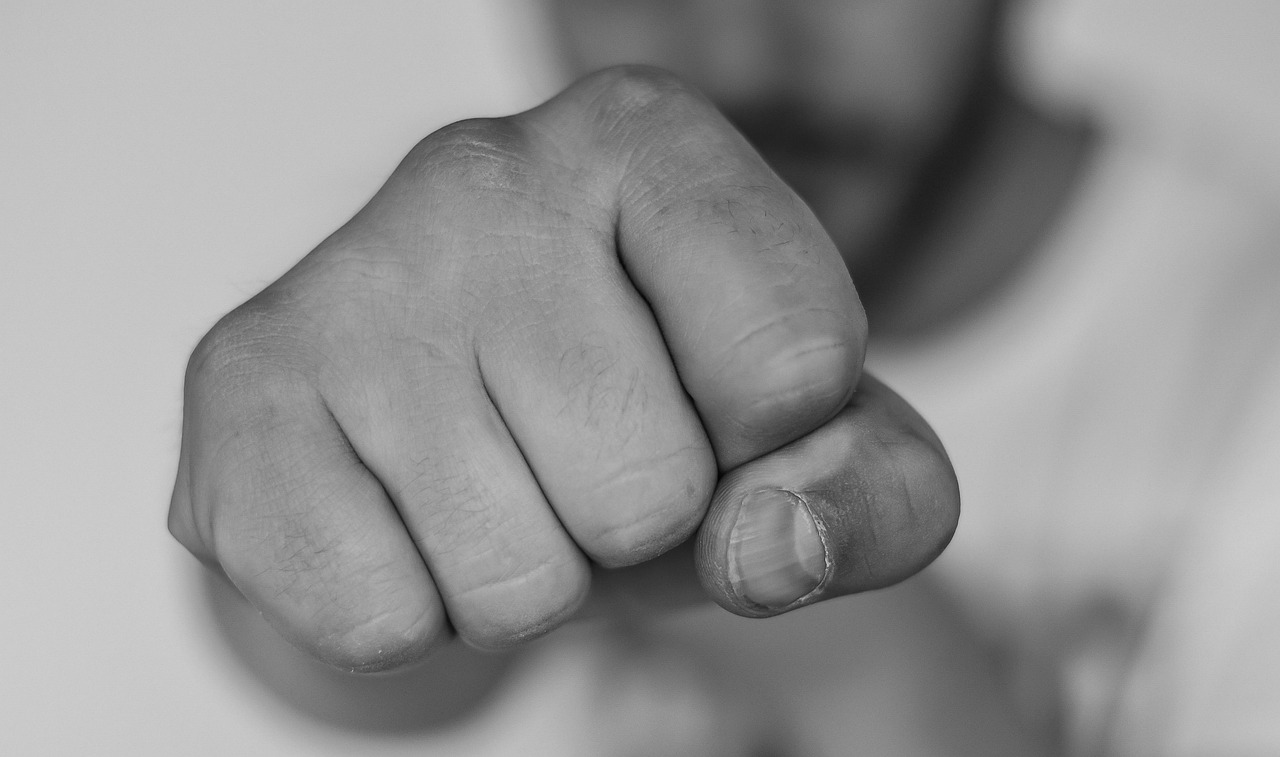In this article, you will discover how self-defense can be a powerful tool for building confidence and courage. Empowerment through self-defense goes far beyond physical techniques; it encompasses a mindset and a set of skills that can transform the way you navigate the world. By learning self-defense, you will not only gain the ability to protect yourself physically but also develop a newfound sense of strength, assertiveness, and resilience. Whether you are a beginner or have some experience, this article will show you why self-defense is not just a means of protection, but a pathway to personal growth and empowerment.

Understanding Self-Defense
Self-defense is the practice of protecting oneself from physical harm or danger. It encompasses a range of techniques and strategies that are designed to enable individuals to defend themselves in threatening situations. Self-defense is not about seeking out violence or engaging in aggressive behavior, but rather about having the confidence and skills to protect oneself when necessary.
Defining Self-Defense
Self-defense can be defined as the act of safeguarding oneself against physical harm or danger using techniques that rely on physical force. It involves learning and practicing specific techniques such as striking, blocking, joint locks, or grappling to effectively defend against an attacker. The main goal of self-defense is to neutralize the threat and ensure one’s personal safety.
Different Types of Self-Defense
Self-defense can vary depending on the situation and the individual’s preferences. Here are some common types of self-defense:
-
Martial Arts: Many martial arts styles, such as Krav Maga, Brazilian Jiu-Jitsu, or Muay Thai, incorporate self-defense techniques into their training. These martial arts emphasize the use of striking, grappling, or a combination of both to defend oneself.
-
Non-Physical Self-Defense: Non-physical self-defense techniques focus on avoiding or de-escalating dangerous situations through tactics such as verbal assertiveness, boundary-setting, and situational awareness. These techniques are particularly useful when physical confrontation can be avoided altogether.
-
Weapon Defense: This type of self-defense focuses specifically on defending oneself against an attacker armed with a weapon. It involves learning techniques to disarm or safely neutralize the threat posed by knives, guns, or other dangerous objects.
The Importance of Self-Defense
Self-defense is crucial for personal safety and empowerment. By learning self-defense, individuals can enhance their confidence, physical strength, and situational awareness. It can also help reduce fear and anxiety, as individuals feel more prepared and capable of protecting themselves in potentially dangerous situations. Moreover, self-defense can have significant psychological benefits, such as boosting self-esteem, fostering empowerment, and building resilience.
Benefits of Self-Defense
Building Confidence
One of the primary benefits of self-defense is the development of confidence. Through regular self-defense training, individuals gain the skills and knowledge necessary to protect themselves effectively. As they become more proficient in self-defense techniques, their confidence increases, and they feel more empowered in their ability to handle potentially threatening situations. This increased confidence can spill over into other areas of life, positively impacting relationships, work, and personal endeavors.
Developing Physical Strength and Agility
Self-defense training involves physical conditioning exercises that build strength, stamina, and agility. Striking techniques, blocks, and joint locks require a combination of strength, speed, and coordination. Regular training improves overall physical fitness, toning muscles, increasing flexibility, and improving cardiovascular endurance. The physical benefits gained through self-defense training contribute to a healthier lifestyle and promote long-term well-being.
Enhancing Situational Awareness
Situational awareness is a crucial aspect of self-defense. By developing an acute awareness of one’s surroundings, individuals can identify potential dangers or threats early on. Self-defense training helps individuals learn to recognize warning signs, assess potential risks, and make informed decisions about how to respond. This heightened sense of situational awareness can not only prevent dangerous situations but also enable individuals to effectively respond if a threat arises.
Promoting Personal Safety
The ultimate goal of self-defense is personal safety. By equipping individuals with the necessary skills and knowledge to protect themselves, self-defense training provides a sense of security and peace of mind. Whether faced with an attacker or confronted with a potentially dangerous situation, individuals who have learned self-defense techniques are better equipped to handle these challenges and keep themselves safe. Self-defense empowers individuals to take control of their personal safety and well-being.
Reducing Fear and Anxiety
Fear and anxiety can be immobilizing, preventing individuals from living their lives to the fullest. Self-defense training helps individuals overcome these feelings by increasing their confidence and providing them with practical tools to manage potential threats. As individuals learn to defend themselves effectively, their fear and anxiety diminish, allowing them to navigate their daily lives with greater freedom and peace of mind.
Psychological Impact of Self-Defense
Boosting Self-Esteem
Self-defense training can have a significant impact on self-esteem. As individuals master self-defense techniques and witness their own progress, their self-worth and self-confidence increase. The sense of accomplishment that comes with learning and applying self-defense skills enhances one’s belief in their own capabilities, creating a positive self-perception that extends beyond physical self-defense.
Fostering Empowerment
Self-defense teaches individuals how to effectively assert themselves and establish boundaries. By developing assertiveness skills, individuals gain a sense of empowerment, knowing that they can defend their rights and protect themselves when necessary. This empowerment allows individuals to navigate challenging situations with confidence and make decisions that align with their own well-being.
Overcoming Trauma and Victim Mentality
For individuals who have experienced trauma or victimization, self-defense can be a powerful tool for healing and reclaiming personal agency. By learning self-defense techniques, survivors of trauma can regain a sense of control and empowerment. Self-defense training helps individuals overcome the psychological impact of trauma and replace feelings of helplessness with strength and resilience.
Building Resilience and Mental Toughness
Self-defense training requires mental fortitude and resilience. It teaches individuals how to remain calm and composed in high-stress situations and make split-second decisions. Through regular training, individuals develop mental toughness, enabling them to persevere in the face of adversity and bounce back from challenges. This resilience cultivated through self-defense training transfers to other areas of life, enhancing overall psychological well-being.
Cultivating Assertiveness
Self-defense involves setting boundaries, expressing oneself clearly, and effectively communicating intentions. These skills translate into assertiveness in various aspects of life, including personal relationships and professional interactions. By cultivating assertiveness, individuals can advocate for themselves, make their needs known, and establish healthy boundaries, leading to more fulfilling relationships and increased self-respect.
Physical Skills in Self-Defense
Basic Striking Techniques
Basic striking techniques, such as punches, kicks, and elbows, are essential components of self-defense. These techniques allow individuals to create distance from an attacker, neutralize threats, and create opportunities for escape. Through proper training and practice, individuals can develop accuracy and power in their strikes, maximizing their effectiveness in self-defense situations.
Effective Blocking and Parrying
Blocking and parrying techniques are used to defend against incoming strikes or attacks. By learning how to properly block or redirect an attacker’s strikes, individuals can protect themselves and minimize the impact of the attack. Effective blocking and parrying techniques are fundamental to self-defense and provide the foundation for counterattacking or escaping from dangerous situations.
Joint Locks and Grappling
Joint locks and grappling techniques are used when close-quarters combat is unavoidable. These techniques involve manipulating an attacker’s joints, muscles, or limbs to gain control or immobilize them. Joint locks and grappling techniques are particularly useful in situations where an attacker is physically larger or stronger, allowing individuals to use leverage and technique to overcome the size and strength disadvantage.
Ground Fighting Techniques
Ground fighting techniques are vital for self-defense in situations where an individual is taken to the ground. Learning how to defend oneself effectively while on the ground is crucial, as it can often be difficult to escape or create distance in such scenarios. Ground fighting techniques focus on leveraging positioning, leverage, and submission holds to neutralize the threat and regain control of the situation.
Weapon Defense Strategies
In an increasingly dangerous world, knowing how to defend against an armed attacker is crucial. Weapon defense strategies teach individuals how to effectively neutralize threats posed by knives, firearms, or other dangerous objects. These techniques typically involve disarming the attacker while minimizing risks to oneself. Learning weapon defense strategies adds an additional layer of protection to an individual’s self-defense skills.

Empowering Women through Self-Defense
Addressing Gender-Based Violence
Gender-based violence is a pervasive issue affecting women worldwide. By learning self-defense techniques, women can develop the skills and confidence necessary to protect themselves against acts of violence and abuse. Self-defense empowers women to reclaim their personal safety and challenge the societal norms that perpetuate violence against women.
Defying Societal Stereotypes
Traditional gender roles often perpetuate the notion that women are vulnerable and in need of protection. Self-defense challenges these stereotypes by promoting women’s autonomy and encouraging personal empowerment. By participating in self-defense training, women can defy societal expectations and shape their own narratives, taking control of their personal safety and well-being.
Promoting Personal Autonomy
Self-defense provides women with the tools they need to assert their autonomy and advocate for themselves. By becoming skilled in physical self-defense, women can navigate the world with greater confidence and assertiveness. This increased personal autonomy empowers women to make choices in their lives that align with their values and aspirations.
Creating a Sense of Community
Self-defense classes often foster a sense of community and support among women. Participating in group self-defense training creates a space for women to connect, share experiences, and learn from one another. This sense of community can enhance women’s overall well-being and provide a support network for continued personal development.
Self-Defense and Personal Growth
Developing Discipline and Focus
Self-defense training requires discipline and focus. Regular practice and dedication are necessary to master the various techniques and strategies involved. By consistently engaging in self-defense training, individuals cultivate discipline and focus, which can be applied to other areas of life, such as work, education, or personal goals.
Improving Mental and Emotional Well-being
Self-defense training not only has physical benefits but also positive effects on mental and emotional well-being. Engaging in physical activity releases endorphins and reduces stress, anxiety, and depression. The mental concentration required during self-defense training helps individuals clear their minds and promote mental clarity and emotional stability.
Setting and Achieving Goals
Self-defense training provides individuals with the opportunity to set and achieve goals. Whether it’s perfecting a specific technique, progressing through belt ranks, or participating in self-defense competitions, there are various milestones that individuals can work towards. This goal-setting aspect of self-defense training helps individuals develop a growth mindset and improved self-confidence.
Embracing a Proactive Mindset
Self-defense training cultivates a proactive mindset, teaching individuals to anticipate and prepare for potential threats. This mindset extends beyond physical self-defense, as individuals become more attuned to recognizing and addressing potential challenges or risks in other areas of life. Embracing a proactive mindset enables individuals to take control of their circumstances and pursue their goals with determination.
Building Resilience in the Face of Challenges
Self-defense training inherently involves facing and overcoming challenges. From physical endurance to learning new techniques, individuals are continually challenged and pushed out of their comfort zones. This process builds resilience and mental toughness, allowing individuals to persevere in the face of adversity and bounce back from setbacks.

Overcoming Barriers to Self-Defense
Fear of Violence and Confrontation
Fear of violence or confrontation can be a significant barrier to self-defense training. However, it is important to acknowledge that self-defense training is primarily focused on prevention and only resorting to physical techniques when necessary. By addressing and working through these fears, individuals can empower themselves to learn the necessary skills to protect themselves effectively.
Lack of Time and Resources
Time constraints and limited resources can hinder individuals from pursuing self-defense training. However, it is important to prioritize personal safety and well-being. Exploring different training options, such as online self-defense programs or finding flexible class schedules, can help individuals overcome these barriers and make self-defense training more accessible.
Difficulty Finding Suitable Self-Defense Classes
Finding suitable self-defense classes can be challenging due to factors such as location, class availability, or specific needs or preferences. However, it is crucial to research and explore different options until finding a program that aligns with individual needs and goals. Discussing specific requirements with instructors or attending trial classes can assist in finding the most suitable self-defense training.
Addressing Cultural and Societal Barriers
Cultural and societal norms can impact individuals’ access to self-defense training, as well as their attitudes and beliefs about personal safety. It is important to challenge and address these barriers by promoting inclusivity, diversity, and open conversations about personal safety within cultural contexts. By acknowledging and embracing the importance of self-defense across cultures, individuals can empower themselves and their communities.
Mindset and Belief Limitations
Sometimes, individuals may be held back by self-imposed limitations or a negative mindset. Beliefs such as “I am not strong enough” or “I am not capable” can hinder progress and personal growth. It is crucial to challenge these limiting beliefs and adopt a growth mindset. With the right mindset, individuals can overcome obstacles and maximize their potential in self-defense and other areas of life.
Choosing the Right Self-Defense Program
Identifying Personal Goals and Preferences
To choose the right self-defense program, it is essential to identify personal goals and preferences. Consider what you want to achieve through self-defense training, whether it’s building confidence, improving physical fitness, or learning specific techniques. Additionally, take into account personal preferences regarding training styles, class sizes, or individual vs. group instruction.
Researching Reputable Self-Defense Programs
Thorough research is crucial when selecting a self-defense program. Look for programs or instructors that have a reputable background, certifications, or positive reviews. Online resources, martial arts associations, or recommendations from trusted sources can help identify reputable self-defense programs in your area or online.
Considering Instructor Qualifications and Experience
The qualifications and experience of self-defense instructors play a vital role in the effectiveness of the program. Ensure that instructors have relevant certifications or qualifications in self-defense or martial arts. Additionally, inquire about their teaching experience and their ability to cater to different skill levels and individual needs.
Evaluating Curriculum and Teaching Methods
Reviewing the curriculum and teaching methods of a self-defense program is crucial to determine if it aligns with personal goals and preferences. Check if the program covers the necessary techniques, emphasizes safety, and provides opportunities for skill progression. Understanding the teaching methods, such as demonstrations, hands-on practice, or theoretical instruction, can help ensure a compatible learning environment.
Trial Classes and Assessing Compatibility
Before committing to a self-defense program, take advantage of trial classes or introductory sessions. Participating in these sessions allows you to experience the teaching style, interact with the instructor, and assess compatibility with your learning style and personality. Use these opportunities to ask questions, clarify expectations, and determine if the program meets your needs.
Embracing Self-Defense as a Lifestyle
Integrating Self-Defense in Daily Routines
Self-defense should not be limited to occasional classes or training sessions. It can be integrated into daily routines by prioritizing personal safety and being aware of potential risks. Simple practices such as maintaining situational awareness, practicing assertiveness, or staying physically fit contribute to an overall self-defense mindset and lifestyle.
Continuing Education and Skill Development
Self-defense skills require ongoing education and practice to maintain proficiency. Continuously seeking opportunities for skill development, such as attending workshops, seminars, or advanced training courses, ensures that individuals stay updated on the latest techniques and can adapt to evolving threats. Committing to lifelong learning in self-defense helps individuals remain prepared and confident in their abilities.
Incorporating Mental and Emotional Self-Defense
Self-defense extends beyond physical techniques and encompasses mental and emotional aspects. Incorporating mental and emotional self-defense strategies, such as stress management techniques, boundary-setting, or assertiveness training, is essential for overall personal well-being and resilience. Developing these skills alongside physical self-defense enhances a holistic approach to personal safety.
Sharing Knowledge and Empowering Others
Once individuals have acquired self-defense skills and knowledge, they can share their expertise with others and help empower them. This can be done by organizing self-defense workshops, volunteering at community centers or schools, or simply sharing information and resources with friends and loved ones. By empowering others through self-defense, individuals contribute to creating safer and more confident communities.
Creating a Personal Safety Plan
Creating a personal safety plan is a proactive step in self-defense. This plan details strategies, resources, and emergency contacts that individuals can rely on in potentially dangerous situations. A personal safety plan helps individuals anticipate and prepare for possible threats, ensuring a confident and informed response in times of crisis.
Self-Defense for All Ages
Teaching Self-Defense to Children and Teens
Equipping children and teenagers with self-defense skills can enhance their personal safety and instill confidence. Specialized self-defense programs for children focus on age-appropriate techniques, boundary-setting, and recognizing potential dangers. These programs teach children how to stay safe, develop assertiveness, and seek help when needed, empowering them to navigate the world with greater autonomy.
Adapting Self-Defense Techniques for Older Adults
Self-defense training can benefit older adults by improving strength, balance, and overall well-being. However, certain adaptations may be necessary to address physical limitations or health concerns. Self-defense programs designed for older adults take into account these considerations and focus on techniques that ensure safety while still being effective for self-defense.
Personal Safety Considerations for Individuals with Disabilities
Self-defense should be accessible to individuals with disabilities, as personal safety is a universal concern. Adaptations can be made to self-defense techniques to accommodate different abilities, ensuring that individuals with disabilities learn effective strategies to protect themselves. Inclusive self-defense programs provide a safe and supportive environment for individuals of all abilities to develop skills and enhance personal safety.
Empowering Marginalized Communities through Self-Defense
Self-defense training can play a crucial role in empowering marginalized communities facing higher rates of violence or discrimination. By equipping individuals in marginalized communities with self-defense skills, organizations and community groups can create safer environments and promote social empowerment. Accessible and culturally sensitive self-defense programs contribute to breaking cycles of victimization and fostering resilience.
Promoting Intergenerational Self-Defense Learning
Self-defense can be an activity that brings generations together. Intergenerational self-defense learning promotes communication, bonding, and the exchange of knowledge between different age groups. Older individuals can share wisdom and life experiences, while younger generations can contribute their energy and enthusiasm. This intergenerational approach fosters mutual support, understanding, and empowerment.
In conclusion, self-defense is about more than physical techniques; it is a holistic practice that empowers individuals to protect themselves, build confidence, and develop resilience. Through self-defense, individuals can enhance their physical strength, mental well-being, and situational awareness. Moreover, self-defense training has the power to transform lives, fostering empowerment, overcoming trauma, and challenging societal norms. By embracing self-defense as a lifestyle, individuals can create safer communities, promote personal growth, and navigate life with confidence and courage.






